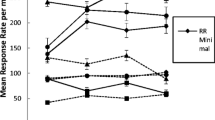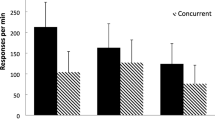Abstract
Experiment 1 was designed to investigate student patterns of responding during fixed-interval (FI) 30-s reinforcement. During the experiment, students were able to respond to multiplication problems by typing answers on the keyboard. Correct answers/min were calculated by the computer program and automatically recorded on disk. Following the experiment, students were questioned regarding what they believed to be the best way to earn the money while working problems. Outcomes from the first experiment showed that only one of the five students was dominated by a pause-respond pattern of temporal disparity. This student provided a verbal rule that accurately described the contingenCies associated with FI reinforcement. The other four students in this experiment responded at relatively constant rates in the majority of their intervals and provided verbal descriptions of contingencies suggesting that reinforcement became available only after the completion of a number or a changing number of problems. Experiment 2 replicated the preparations of Experiment 1; however, prior to initiated computerinteractive problem solving, the two subjects were shown the accurate rule generated by the subject in Experiment 1 who had exhibited pause-respond performance. Response patterns produced by these subjects showed conspicuous and consistent patterns of pauserespond throughout all intervals of FI 30-s reinforcement. Experiment 3 was conducted to further assess the possibility that scalloping (or some other pattern) might emerge over an extended series of sessions. Outcomes confirmed that performance patterns did not change significantly over sessions. Moreover, the subjects’ verbal description of programmed contingencies conformed to the pattern of responding they produced. Outcomes are discussed in terms of selfgenerated and socially mediated rule-following.
Similar content being viewed by others
References
BAXTER, G. A., & SCHLINGER, H. (1990). Performance of children under a multiple random-ratio random-interval schedule of reinforcement. Journal of the Experimental Analysis of Behavior, 54, 263–271.
BENTALL, R. P., & LOWE, C. F. (1987). The role of verbal behavior in human learning: III. Instructional effects in children. Journal of the Experimental Analysis of Behavior, 47, 177–190.
BENTALL, R. P., LOWE, C. F., & BEASTY, A. (1985). The role of verbal behavior in human learning: II. Developmental differences. Journal of the’ Experimental Analysis of Behavior, 43, 165–181.
CATANIA, A. C. (1992). Learning: Third Edition. Englewood Cliffs, NJ: Prentice Hall.
CATANIA, A. C., SHIMOFF, E., & MATTHEWS, B. A. (1989). An experimental analysis of rule-governed behavior. In S. C. Hayes (Ed.), Rule-governed behavior: Cognition, contingencies, and instructional control (pp. 119–150). New York: Plenum Press.
CERUTTI, D. T. (1991). Discriminative versus reinforcing properties of schedules as determinants of schedule insensitivity in humans. The Psychological Record, 41, 51–67.
DECASPER, A. J., & ZEILER, M. D. (1972). Steady-state behavior in children: A method and some data. Journal of Experimental Child Psychology, 13, 231–239.
DEWS, P. B. (1978). Studies on responding under fixed-interval schedules of reinforcement: II. The scalloped pattern of the cumulative record. Journal of the Experimental Analysis of Behavior, 29, 67–75.
FERSTER, C. B., & SKINNER, B. F. (1957). Schedules of reinforcement. New York: Appleton-Century-Crofts.
HAYES, S. C., BROWNSTEIN, A. J., ZETTLE, R. D., ROSENFARB, I., & KORN, Z. (1986). Rule-governed behavior and sensitivity to changing consequences of responding. Journal of the Experimental Analysis of Behavior, 45,. 237–256.
HAYES L. J., DIXON M. R., Caslake D. L., BECKWITH J. L., & SHURR C. S. (1997). Deviations from animal standards in human schedule performances through self-generated verbal behavior. Mexican Journal of Behavior Analysis, 23, 53–65.
HAYES, S. C., ZETTLE, R. D., & ROSENFARB, I. (1989). Rule-following. In S. C. Hayes (Ed.), Rule-governed behavior: Cognition, contingencies, and instructional control (pp.191–220). New York: Plenum.
HYTEN, C., & MADDEN, G. J. (1993). The scallop in human fixed-interval research: A review of problems with data description. The Psychological Record, 43, 471–500.
LIPPMAN, L. G., & MEYER, M. M. (1967). Fixed interval performance as related to instructions and to subjects’ verbalization of the contingency. Psychonomic Science, 8, 135–136.
LOWE, C. F. (1979). Determinants of human operant behavior. In M. D. Zeiler & P. Harzem (Eds.), Advances in analysis of behaviour (Vol. 1), Reinforcement and the organization of behaviour. Chichester and New York: Wiley.
LOWE, C. F., BEASTY, A., & BENTALL, R. P. (1983). The role of verbal behavior in human learning: Infant performance on fixed-interval schedules. Journal of the Experimental Analysis of Behavior, 39, 157–164.
LOWE, C. F., HARZEM, P., & BAGSHAW, M. (1978). Species differences in temporal control of behavior II: Human performance. Journal of the Experimental Analysis of Behavior, 29, 351–361.
LOWE, C. F., & HORNE, P. J. (1996). Reflections on naming and other symbolic behavior. Journal of the Experimental Analysis of Behavior, 65, 315–340.
MADDEN, G. J., CHASE, P. N., & JOYCE, J. H. (1998). Making sense of sensitivity in the human operant literature. The Behavior Analyst, 21, 1–12.
MALOTT, R. W., WHALEY, D. L., & MALOTT, M. E. (1997). Elementary principles of behavior: (3rd ed.). Upper Saddle River, NJ: Prentice Hall.
NINNESS, H. A. C., & NINNESS, S. K. (1998). Superstitious math performance: Interactions between rule-governed and schedule contingencies. The Psychological Record, 48, 45–62.
NINNESS, H. A. C., & NINNESS, S. K. (1999). Contingencies of superstition: Selfgenerated rules and responding during second-order response-independent schedules. The Psychological Record, 49, 221–243.
NINNESS, C., SHORE, T., & NINNESS, S. K. (1999). Shaping and instructing performance descriptions during computer-interactive problem solving. The Psychological Record, 49, 629–644.
ROSENFARB, L S., NEWLAND, M. C., BRANNON, S. E., & HOWEY, D. S. (1992). Effects of self-generated rules on the development of schedule-controlled behavior. Journal of the Experimental Analysis of Behavior, 58, 107–121.
SLAVIN, R. E. (1997). Educational psychology: Theory and practice (5th ed.). Needham Heights, MA: Allyn and Bacon.
WEINER, H. (1970). Human behavioral persistence. The Psychological Record, 20, 445–456.
WEISBERG, P., & FINK, E. (1966). Fixed ratio and extinction performance of infants in the second year of life. Journal of the Experimental Analysis of Behavior, 9(2), 105–109.
WEISBERG, P., & WALDROP, P. B. (1972). Fixed-interval work habits of Congress. Journal of Applied Behavior Analysis, 5, 93–97.
Author information
Authors and Affiliations
Corresponding author
Additional information
This investigation was supported in part by Stephen F. Austin State University Faculty Research Grant 1-14008. We gratefully acknowledge the helpful comments provided by Cloyd Hyten in the development of this study.
Rights and permissions
About this article
Cite this article
Chris Ninness, H.A., Ozenne, L., Mcculler, G. et al. Fixed-Interval Responding During Human Computer-Interactive Problem Solving. Psychol Rec 50, 387–401 (2000). https://doi.org/10.1007/BF03395362
Published:
Issue Date:
DOI: https://doi.org/10.1007/BF03395362




